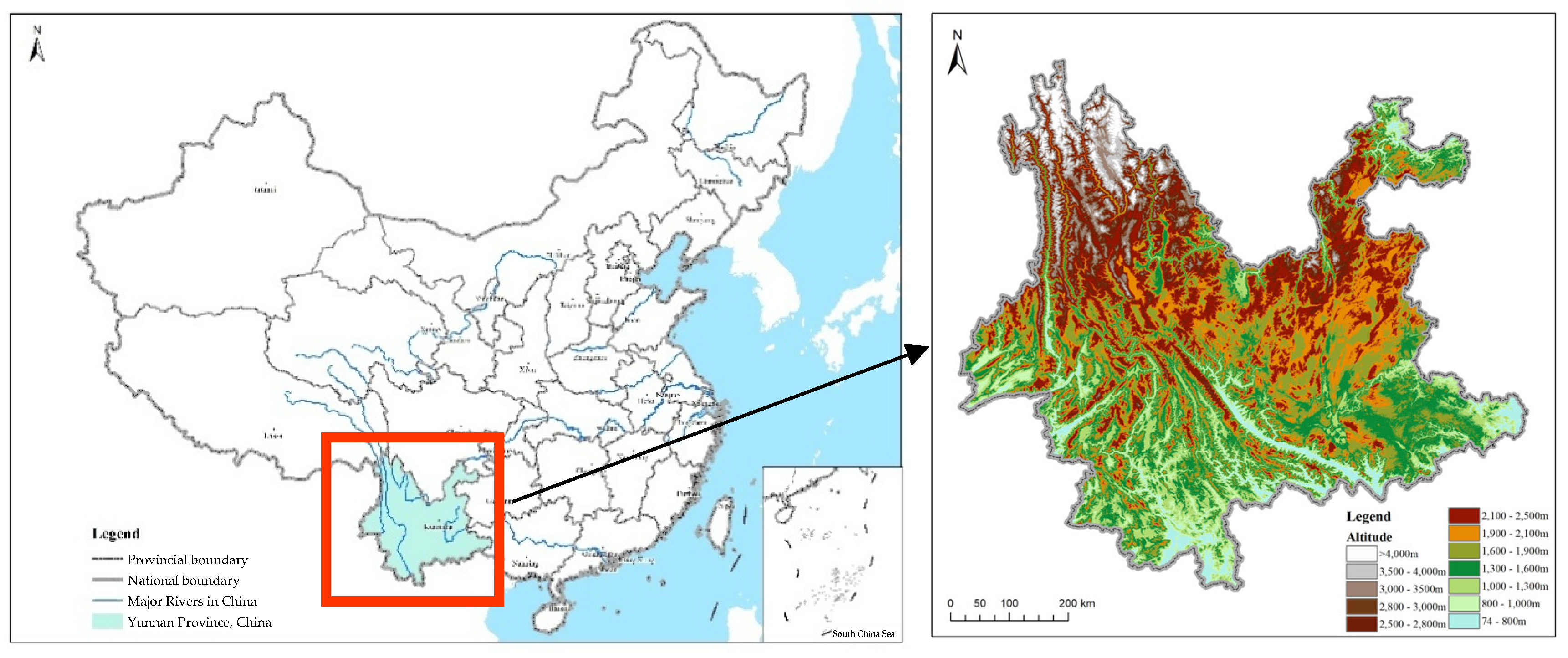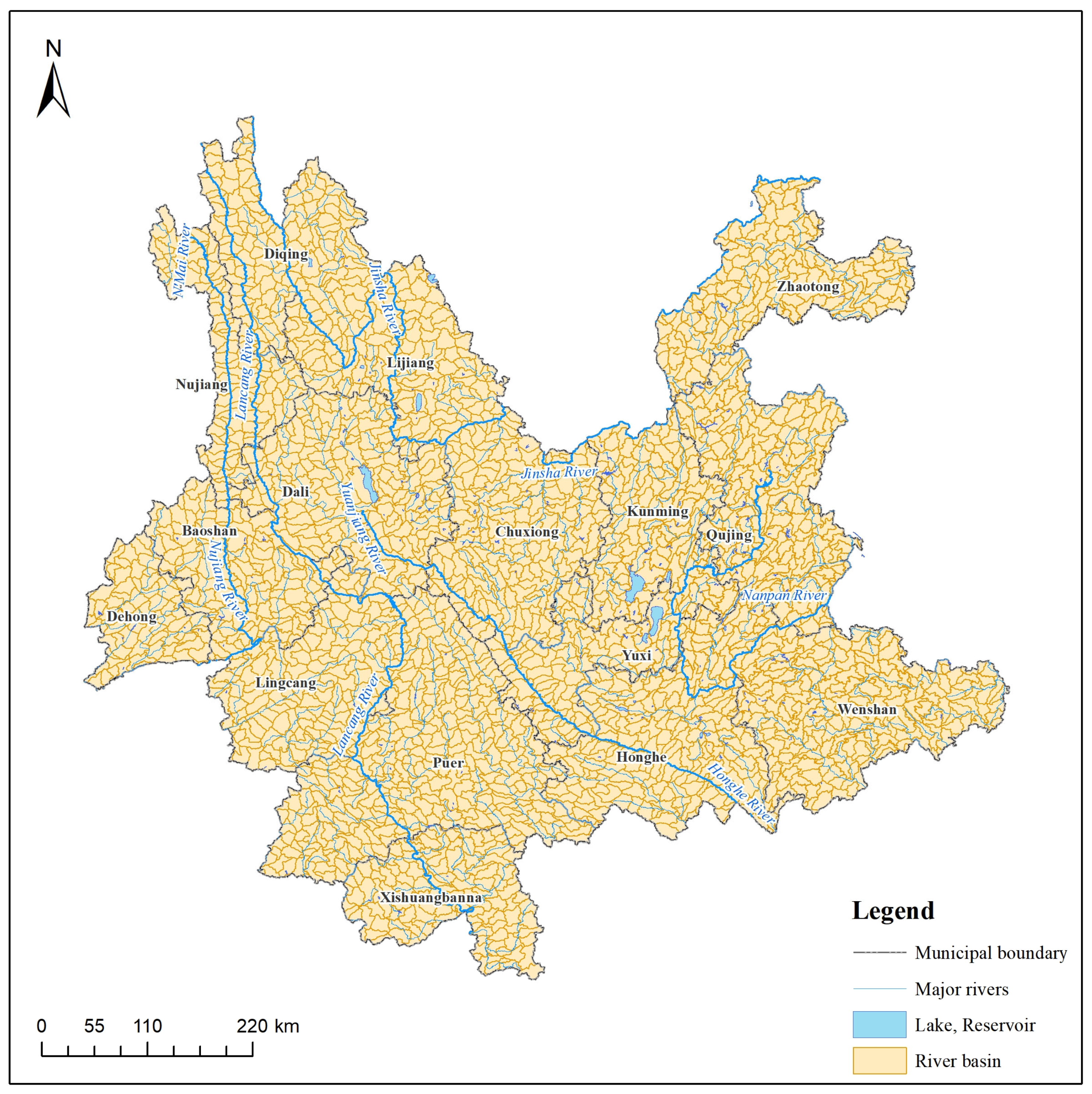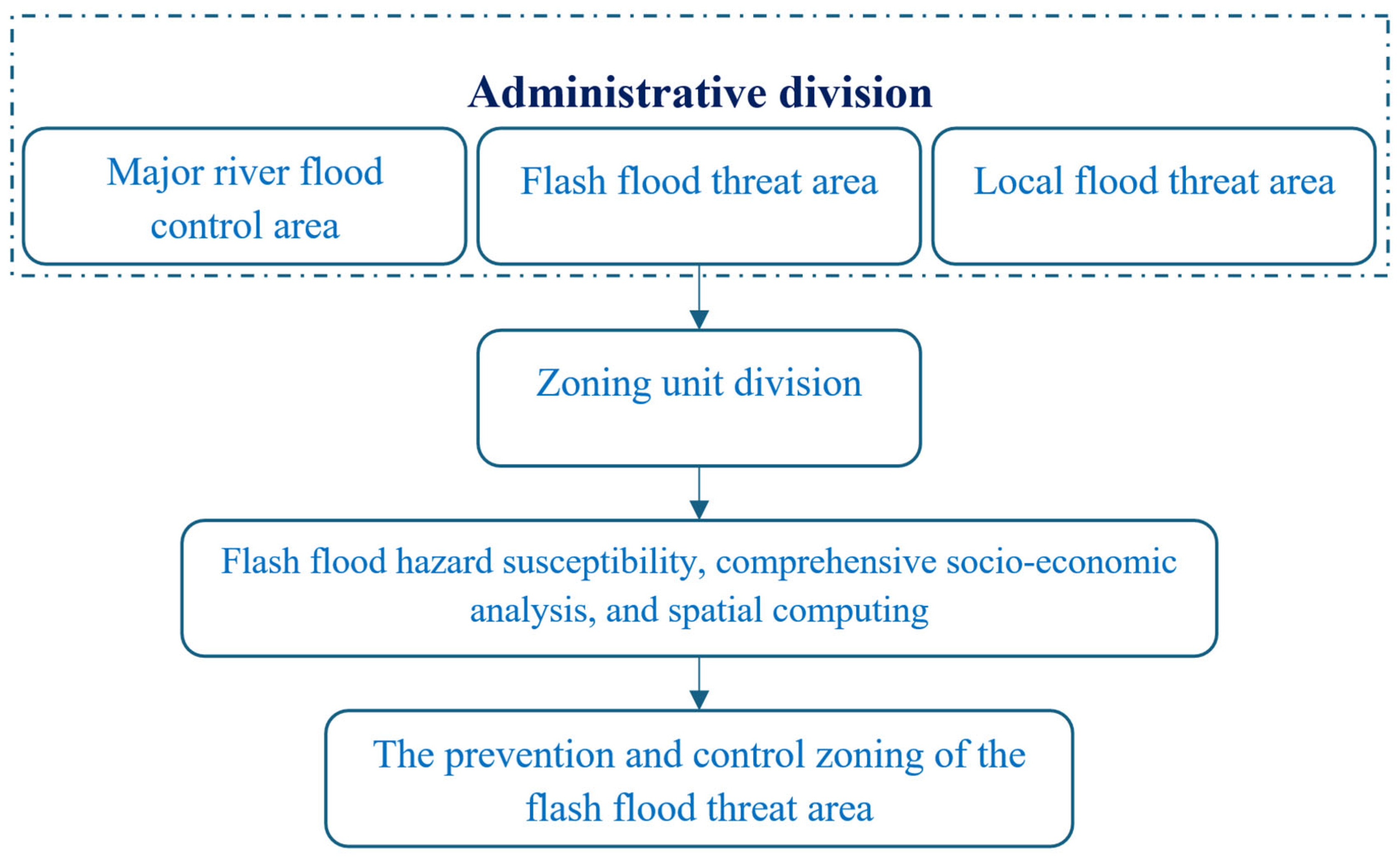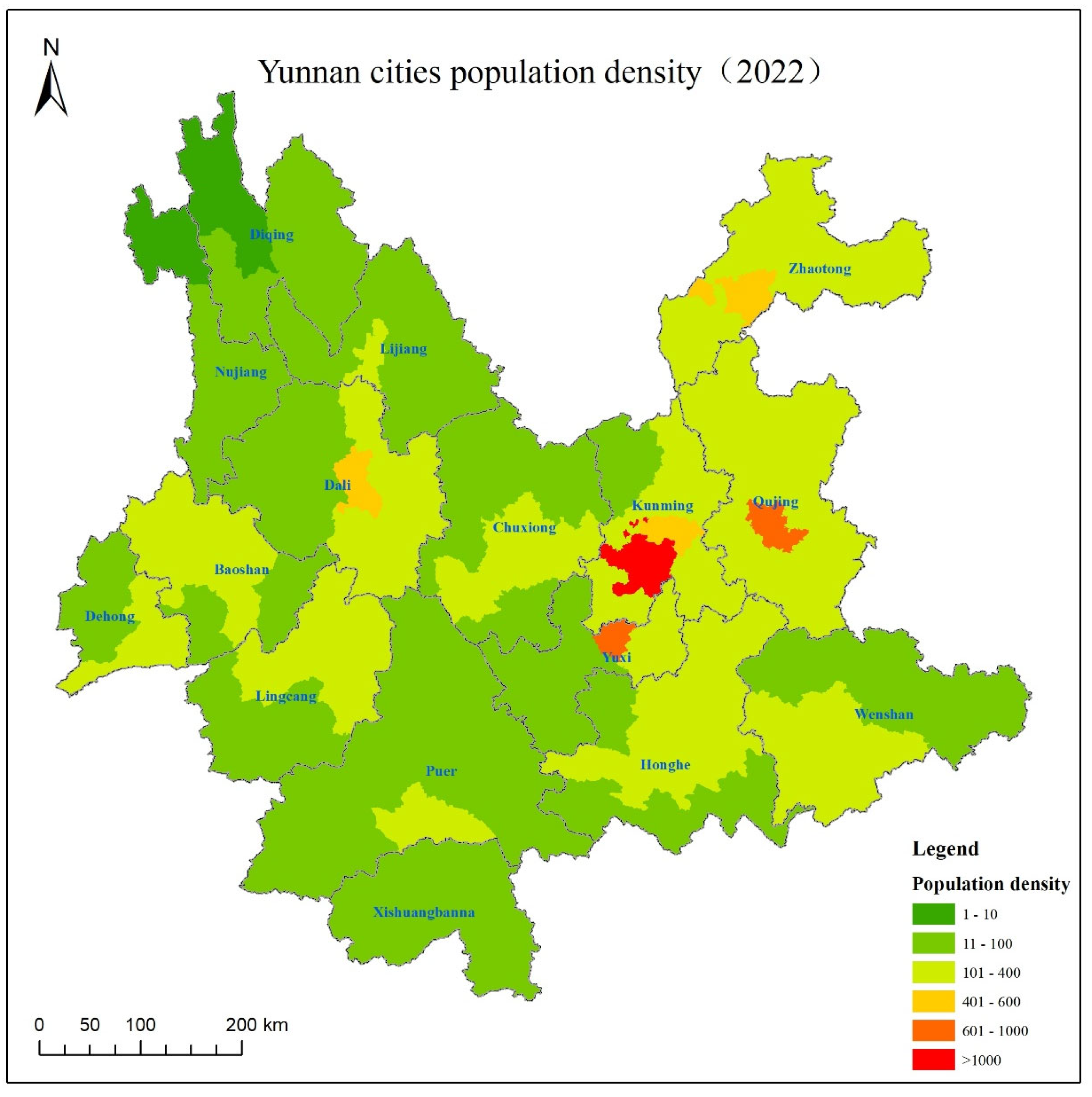A Study on the Zoning Method of Flash Flood Control for Mountainous Cities: A Case Study of Yunnan Province
Abstract
1. Introduction
2. Research Area and Data
2.1. Study Area Overview
2.2. Data Source and Collation
3. Technology Roadmap and Calculation Method
Technology Roadmap
- Level 1:
- Level 2:
- Level 3:
- where n is the number of people affected by flash floods in the watershed. By comparing n with the calculated values of N1 and N2, the grade of the population affected by flash floods in the small watershed is determined.
4. Results Analysis
4.1. Summary of Decision Factors
4.2. Analysis of Calculation Results
4.2.1. Key Prevention and Controlled Zoning for Flash Floods
4.2.2. Medium Prevention and Controlled Zoning for Flash Floods
4.2.3. General Prevention and Control Zoning for Flash Floods
5. Conclusions
Author Contributions
Funding
Institutional Review Board Statement
Informed Consent Statement
Data Availability Statement
Conflicts of Interest
References
- Liu, Y. Study on Spatiotemporal Distribution and Heterogeneity of Driving Forces of Flash Flood in China. Ph.D. Thesis, Tianjin University, Tianjin China, 2017. [Google Scholar]
- Sun, D.; Zhang, D.; Cheng, X. Framework of National Non-structural Measures for Flash Flood Disaster Prevention in China. Water 2012, 4, 272–282. [Google Scholar] [CrossRef]
- Camorani, G.; Castellarin, A.; Brath, A. Effects of Land-use Changes on the Hydrologic Response of Reclamation Systems. Phys. Chem. Earth 2005, 30, 561–574. [Google Scholar] [CrossRef]
- Guoyi, L.I.; Jiahong, L.; Weiwei, S. Urban Flood Risk Assessment Under Rapid Urbanization in Zhengzhou City, China. Reg. Sustain. 2023, 4, 332–348. [Google Scholar] [CrossRef]
- Dawei, Z.; Quan, J.; Zhang, H.; Wang, F.; Wang, H.; He, X. Flash Flood Hazard Mapping: A Pilot Case Study in Xiapu River Basin. Water Sci. Eng. 2015, 8, 195–204. [Google Scholar] [CrossRef]
- Qiu, H.; Hu, B.; Zhang, Z. Impacts of Land Use Change on Ecosystem Service Value Based on SDGs Report--Taking Guangxi as an Example. Ecol. Indic. 2021, 133, 108366. [Google Scholar] [CrossRef]
- Li, Y.; Weimin, Y.E.; Shaoxuan, D. Lessons Africa Can Learn from China’s Experience in Urbanization. Int. Relat. Dipl. 2023, 11, 125–134. [Google Scholar] [CrossRef]
- Farrell, K.; Westlund, H. China's Rapid Urban Ascent: An Examination Into the Components of Urban Growth. Asian Geogr. 2018, 35, 85–106. [Google Scholar] [CrossRef]
- Sharma, A.; Poonia, M.; Rai, A.; Biniwale, R.B.; Tiwari, A.; Lachure, S.; Tuegel, F.; Holzbecher, E.; Hinkelmann, R. Impact of Land Use and Rainfall Change on Runoff and Flood Resilience of an Urban Environment: A Case Study of Chennai City, India. Arab. J. Geosci. 2024, 7, 17. [Google Scholar] [CrossRef]
- Li, H.; Wang, Y.; Ping, L.; Li, N.; Zhao, P. Comprehensive Zoning Strategies for Flood Disasters in China. Water 2024, 16, 2546. [Google Scholar] [CrossRef]
- Fang, C. Study on Spatial Pattern of China Mountainous cities—Morden and Contemporary Part. Master’s Thesis, Chongqing University, Chongqing, China, 2015. [Google Scholar]
- Zhang, Z.; Li, Q.; Liu, C.; Ding, L.; Ma, Q.; Chen, Y. Driving Effects and Spatial-Temporal Variations in Economic Losses Due to Flood Disasters in China. Water 2022, 14, 2266. [Google Scholar] [CrossRef]
- NOAA/NWS. Flash Flood Guidance Improvement Team; National Weather Service Final Report; National Weather Service: Washington, DC, USA, 2003.
- Islam, M.M.; Ujiie, K.; Noguchi, R.; Ahamed, T. Flash Flood-induced Vulnerability and Need Assessment of Wetlands Using Remote Sensing, GIS, and Econometric Models. Remote Sens. Appl. Soc. Environ. 2022, 25, 100692. [Google Scholar] [CrossRef]
- Knocke, E.T.; Kolivras, K.N. Flash Flood Awareness in Southwest Virginia. Risk Anal. 2010, 27, 155–169. [Google Scholar] [CrossRef] [PubMed]
- Liu, C.; Guo, L.; Ye, L.; Zhang, S.; Song, T. A Review of Advances in China’s Flash Flood Early-warning System. Nat. Hazards 2018, 92, 619–634. [Google Scholar] [CrossRef]
- Ren, H.; Zhang, P.; Yang, Q.; Hu, W. Theory and Practice on Areas Division of Mountain Flood Prevention in China. Chin. Water Resour. 2005, 14, 17–20. [Google Scholar]
- Ma, J.; Zhang, P.; Ren, H. The Study on the Method of Chinese Mountain Torrents Disaster Prevention Regionalization. Chin. Water Resour. 2007, 14, 21–24. [Google Scholar]
- Wang, X.; Yue, L.; Yuwei, H. Study of Regionalization of Flash Flood Prevention Based on GIS Index Model. Water Resour. Power 2011, 29, 54–57. [Google Scholar]
- Wang, N.; Lombardo, L.; Tonini, M.; Cheng, W.; Guo, L.; Xiong, J. Spatiotemporal Clustering of Flash Floods in a Changing Climate (China, 1950–2015). Nat. Hazards Earth Syst. Sci. 2021, 21, 2109–2124. [Google Scholar] [CrossRef]
- Li, C.; Guo, L.; Liu, C.; Sun, D. Preliminary Studies on Mountain Flood Disaster Evaluation. Chin. Water Resour. 2014, 18, 14–17. [Google Scholar]
- Zhang, X.; Li, C.; Sun, D. Research on National Flash Flood Disasters Risk Zoning Based on Survey and Evaluation of Big Data. Chin. Flood Drought Manag. 2020, 30, 61–63. (In Chinese) [Google Scholar]
- Yuan, J. Study on the Influence of Urbanization on Flood Characteristics of Small and Medium Rivers in Mountain Area. Master’s Thesis, Chongqing Jiaotong University, Chongqing, China, 2017. [Google Scholar]
- Wang, D.; Yuan, S.; Yang, C.; Zhu, X.; Luo, L. Investigation and Evaluation of Flash Flood Disasters in Yunnan Province. Chin. Flood Drought Manag. 2018, 28, 40–43,47. [Google Scholar] [CrossRef]
- Wang, M.; Wu, Y.; Hu, P. Study on Spatial and Temporal Patterns of Land Use in Mountainous Areas of Yunnan Province from Perspective of Terrain Gradient. Acta Agric. Jiangxi 2020, 32, 123–131. [Google Scholar] [CrossRef]
- Cheng, J.; Xie, M. The Analysis of Regional Climate Change Features over Yunnan in Recent 50 Years. Prog. Geogr. 2008, 27, 19–26. [Google Scholar]
- Yu, H.; Yingmei, W.; Chen, L.; Min, W.; Yan, Z. Spatial and Temporal Evolution and Multi-scenario Modeling of Land Use and Habitat Quality in Highland Mountainous Urban Agglomeration of Central Yunnan, Southwest China. Chin. J. Appl. Ecol. 2024, 35, 2842. [Google Scholar] [CrossRef]
- Hu, J.; Xu, G.; Wang, Y. Characteristic of Mountain Torrents and its Vulnerability Zoning in Yuxi City. J. Eng. Geol. 2006, 14, 213–218. [Google Scholar]
- Tao, Y.; Tang, C.; Cun, C.Q.; Yang, X.D. The Meteorological Causes for Flash Flood and Debris Flow on July 5, 2004 in Dehong Prefecture of Yunnan Province. Mt. Res. 2005, 23, 53–62. [Google Scholar]
- Gao, K.C.; Meng, G.C.; Wei, F.Q. Analysis and Counter-Measure for the Large-Scale Landslide-Debris Flow Hazard in Dehong, Yunnan, China. J. Disaster Prev. Mitigat Eng. 2005, 25, 251–257. [Google Scholar]
- Dongsheng, W.; Shutang, Y.; Liyan, L. Analysis of Causes and Countermeasures of ‘2016.7.5’ Flash Flood Disaster in Zhaotong City, Yunnan Province. Chin. Flood Drought Manag. 2019, 29, 5–10. [Google Scholar] [CrossRef]





| Socio-economic status The designed rainfall frequency corresponding to the critical rainfall | More than 1000 people were affected by the flash floods or the national and provincial important infrastructure and industrial and mining enterprises are seriously affected by flash floods. | More than 500 people were affected by the flash floods or the prefecture-level important infrastructure and industrial and mining enterprises are seriously affected by flash floods. | Less than 500 people were affected by the flash floods, and no important infrastructure or industrial and mining enterprises were affected by flash floods. |
| The critical rainfall ≤ designed rainfall p = 20% | key prevention and controlled zoning for flash floods | key prevention and controlled zoning for flash floods | medium prevention and controlled zoning for flash floods |
| Designed rainfall p = 5% ≥ The critical rainfall > designed rainfall p = 20% | key prevention and controlled zoning for flash floods | medium prevention and controlled zoning for flash floods | general prevention and control zoning for flash floods |
| The critical rainfall > designed rainfall p = 5% | medium prevention and controlled zoning for flash floods | general prevention and controlled zoning for flash floods | general prevention and controlled zoning for flash floods |
| Level of Population Threatened by Flash Floods Flood Control Capacity | |||
|---|---|---|---|
| Less than once in a 5-year return period | key prevention and controlled zoning for flash floods | key prevention and controlled zoning for flash floods | medium prevention and controlled zoning for flash floods |
| More than once in a 5-year return period but less than once in a 20-year return period | key prevention and controlled zoning for flash floods | medium prevention and controlled zoning for flash floods | general prevention and controlled zoning for flash floods |
| More than once in a 20-year return period | medium prevention and controlled zoning for flash floods | general prevention and controlled zoning for flash floods | general prevention and controlled zoning for flash floods |
| City Name | Below the 5-Year Return Period | Higher Than the 5-Year Return Period and Below the 20-Year Return Period | Higher Than the 20-Year Return Period and Below the 100-Year Return Period | Higher Than the 100-Year Return Period | Total |
|---|---|---|---|---|---|
| Kunming | 307 (28.64%) | 307 (28.64%) | 160 (14.93%) | 298 (27.80%) | 1072 |
| Qujing | 26 (2.89%) | 237 (26.33%) | 419 (46.56%) | 218 (24.22%) | 900 |
| Yuxi | 92 (13.43%) | 392 (57.23%) | 201 (29.34%) | 0 (0%) | 685 |
| Baoshan | 12 (2.15%) | 115 (20.57%) | 243 (43.47%) | 189 (33.81%) | 559 |
| Zhaotong | 202 (16.22%) | 496 (39.84%) | 489 (39.28%) | 58 (4.66%) | 1245 |
| Lijiang | 56 (9.84%) | 190 (33.39%) | 204 (35.85%) | 119 (20.91%) | 569 |
| Puer | 132 (19.50%) | 193 (28.51%) | 331 (48.89%) | 21 (3.10%) | 677 |
| Lingcang | 17 (4.08%) | 97 (23.26%) | 280 (67.15%) | 23 (5.52%) | 417 |
| Chuxiong | 105 (12.17%) | 262 (30.36%) | 335 (38.82%) | 161 (18.66%) | 863 |
| Honghe | 40 (3.93%) | 343 (33.69%) | 524 (51.47%) | 111 (10.90%) | 1018 |
| Wenshan | 89 (10.19%) | 183 (20.96%) | 343 (39.29%) | 258 (29.55%) | 873 |
| Xishuangbanna | 93 (30.59%) | 108 (35.53%) | 83 (27.30%) | 20 (6.58%) | 304 |
| Dali | 59 (4.21%) | 480 (34.21%) | 634 (45.19%) | 230 (16.39%) | 1403 |
| Dehong | 154 (42.08%) | 132 (36.07%) | 43 (11.75%) | 37 (10.11%) | 366 |
| Nujiang | 2 (0.73%) | 163 (59.71%) | 43 (15.75%) | 65 (23.81%) | 273 |
| Diqing | 77 (23.77%) | 118 (36.42%) | 129 (39.81%) | 0 (0%) | 324 |
| Total | 1463 (12.67%) | 3816 (33.04%) | 4461 (38.63%) | 1808 (15.66%) | 11,548 |
| City Name | Highest-Risk Area | High-Risk Area | Dangerous Areas | Total |
|---|---|---|---|---|
| Kunming | 26,871 (37.39%) | 21,842 (30.39%) | 23,149 (32.21%) | 71,862 |
| Qujing | 261 (1.02%) | 8585 (33.71%) | 16,623 (65.27%) | 25,469 |
| Yuxi | 5802 (15.65%) | 23,738 (64.04%) | 7526 (20.30%) | 37,066 |
| Baoshan | 122 (1.33%) | 1423 (15.48%) | 7647 (83.19%) | 9192 |
| Zhaotong | 2814 (6.20%) | 12,515 (27.59%) | 30,036 (66.21%) | 45,365 |
| Lijiang | 895 (6.20%) | 5231 (36.22%) | 8318 (57.59%) | 14,444 |
| Puer | 5210 (40.09%) | 3148 (24.22%) | 4638 (35.69%) | 12,996 |
| Lingcang | 112 (2.96%) | 859 (22.70%) | 2813 (74.34%) | 3784 |
| Chuxiong | 1444 (9.56%) | 6186 (40.97%) | 7470 (49.47%) | 15,100 |
| Honghe | 283 (2.24%) | 4434 (35.15%) | 7898 (62.61%) | 12,615 |
| Wenshan | 1123 (6.12%) | 7085 (38.63%) | 10,134 (55.25%) | 18,342 |
| Xishuangbanna | 3196 (26.40%) | 3438 (28.39%) | 5474 (45.21%) | 12,108 |
| Dali | 1149 (4.56%) | 10,381 (41.18%) | 13,678 (54.26%) | 25,208 |
| Dehong | 16,962 (64.56%) | 5625 (21.41%) | 3688 (14.04%) | 26,275 |
| Nujiang | 5 (0.11%) | 2478 (56.78%) | 1881 (43.10%) | 4364 |
| Diqing | 1938 (61.15%) | 863 (27.23%) | 368 (11.61%) | 3169 |
| Total | 68,187 (20.21%) | 117,831 (34.93%) | 151,341 (44.86%) | 337,359 |
| City Name | Key Prevention and Controlled Zoning | Medium Prevention and Controlled Zoning | General Prevention and Control Zoning | Total |
|---|---|---|---|---|
| Kunming | 6473.78 | 7998.69 | 5259.14 | 19,731.61 |
| Qujing | 764.84 | 3791.89 | 14,193.02 | 18,749.76 |
| Yuxi | 899.90 | 9009.24 | 18,169.58 | 28,078.72 |
| Baoshan | 863.17 | 6730.18 | 20,090.13 | 27,683.47 |
| Zhaotong | 2649.73 | 3875.16 | 4129.44 | 10,654.32 |
| Lijiang | 53.30 | 7802.36 | 15,172.34 | 23,028.00 |
| Puer | 970.11 | 6335.20 | 24,687.93 | 31,993.24 |
| Lingcang | 957.19 | 3955.37 | 15,315.58 | 20,228.14 |
| Chuxiong | 447.29 | 4257.86 | 18,667.56 | 23,372.70 |
| Honghe | 588.33 | 5948.41 | 7964.48 | 14,501.22 |
| Wenshan | 842.46 | 13,872.69 | 28,945.00 | 43,660.15 |
| Xishuangbanna | 1644.61 | 7805.80 | 19,158.13 | 28,608.54 |
| Dali | 2388.71 | 7126.94 | 21,966.51 | 31,482.15 |
| Dehong | 1549.36 | 7649.20 | 9588.53 | 18,787.09 |
| Nujiang | 3745.60 | 4637.11 | 6030.25 | 14,412.97 |
| Diqing | 4710.99 | 7475.43 | 10,076.05 | 22,262.48 |
| Total | 29,549.35 | 108,271.52 | 239,413.68 | 377,234.56 |
Disclaimer/Publisher’s Note: The statements, opinions and data contained in all publications are solely those of the individual author(s) and contributor(s) and not of MDPI and/or the editor(s). MDPI and/or the editor(s) disclaim responsibility for any injury to people or property resulting from any ideas, methods, instructions or products referred to in the content. |
© 2025 by the authors. Licensee MDPI, Basel, Switzerland. This article is an open access article distributed under the terms and conditions of the Creative Commons Attribution (CC BY) license (https://creativecommons.org/licenses/by/4.0/).
Share and Cite
Zhang, Z.; Li, Q.; Liu, C.; Chen, Y. A Study on the Zoning Method of Flash Flood Control for Mountainous Cities: A Case Study of Yunnan Province. Appl. Sci. 2025, 15, 4781. https://doi.org/10.3390/app15094781
Zhang Z, Li Q, Liu C, Chen Y. A Study on the Zoning Method of Flash Flood Control for Mountainous Cities: A Case Study of Yunnan Province. Applied Sciences. 2025; 15(9):4781. https://doi.org/10.3390/app15094781
Chicago/Turabian StyleZhang, Zhixiong, Qing Li, Changjun Liu, and Yao Chen. 2025. "A Study on the Zoning Method of Flash Flood Control for Mountainous Cities: A Case Study of Yunnan Province" Applied Sciences 15, no. 9: 4781. https://doi.org/10.3390/app15094781
APA StyleZhang, Z., Li, Q., Liu, C., & Chen, Y. (2025). A Study on the Zoning Method of Flash Flood Control for Mountainous Cities: A Case Study of Yunnan Province. Applied Sciences, 15(9), 4781. https://doi.org/10.3390/app15094781







